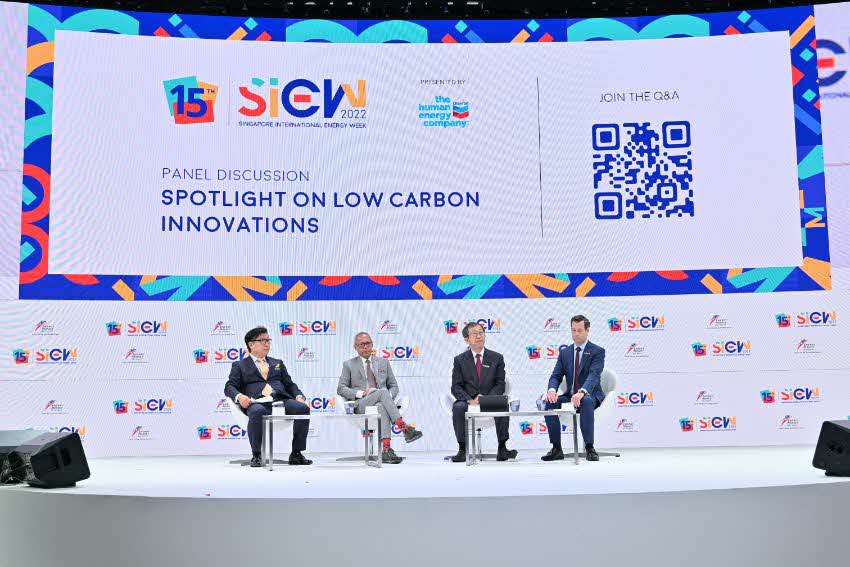What are the major challenges inhibiting the meaningful deployment of hydrogen and other low carbon alternatives? Lim Wen Bin, Head of Renewable ASPAC, KPMG Singapore, reports. This article is contributed by KPMG - the official Content Partner for SIEW 2022.

How do you achieve a low carbon economy? To answer that very question, panellists were involved in robust discussion on "Spotlight on Low Carbon Innovations", one of the panel discussions under the Singapore Energy Summit on 25 October.
Tatsuya Terazawa, Chairman & Chief Executive Officer of the Institute of Energy Economics, Japan (IEEJ), opened the panel by inviting fellow energy speakers to share their perspectives on low carbon technologies that have the potential to make the greatest impact.
Austin Knight, Vice President of Hydrogen at Chevron New Energies, shared his view that hydrogen and ammonia have an important role to play in the energy transition. Both versatile fuels can act as key enablers to provide affordable, reliable and clean energy.
Agreeing, Toshiro Kudama, Chief Executive Officer of JERA Asia, emphasised the need for low carbon solutions to be able to provide round-the-clock energy. To this point, he shared that JERA Asia is committed to advancing green ammonia development.
Mr Kudama articulated why ammonia is particularly well-suited to deliver on decarbonisation and supported his view with three key reasons. The first is that ammonia has a high hydrogen content and emits zero carbon dioxide even during combustion. Secondly, ammonia is relatively easy to handle in that it liquifies at below –33°C at ambient temperature settings compared with other forms of energy carriers which require much lower temperatures for liquefaction. Finally, ammonia is already widely utilised by the industrial and agricultural sectors. He shared that clear government policy support will be critical to help scale up adoption in clean ammonia.
Another low carbon solution is geothermal, said Ahmad Yuniarto, President Director of PT Pertamina Geothermal Energy. He highlighted the vast indigenous resource potential that geothermal has to offer as a baseload low carbon energy source that can provide reliable energy.
When asked why geothermal energy has not taken off in a large scale despite its clear benefits, Mr Yuniarto said this was due to the vastly different risk profiles associated with geothermal development.
Unlikely other renewable energy sources, the development risk of geothermal is closer to upstream drilling risks faced by oil and gas companies. Geothermal energy is also less familiar as a renewable source to utilities and power developers. Mr Yuniarto said de-risking early-stage geothermal development with well-priced blended finance is seen as an important step to overcoming development stage geothermal projects and unlocking this potentially vast indigenous resource.
Barriers to accelerating low carbon solutions
On the topic of key challenges that inhibit the meaningful development of low carbon solutions, Mr Knight shared his view that hydrogen is already happening, and is here to stay. Chevron New Energies has been investing in laying the foundations required, including developing carbon capture partnerships and ecosystems in the region. This is with the anticipation that demand for and adoption of hydrogen at scale may be as early as 2030.
He also shared that low carbon hydrogen, while currently more expensive, is expected to have a significant cost reduction potential. This will come around as production scales up and access to low-cost renewable energy supply continues to grow.
Mr Terazawa concurred by drawing an analogy to when Japan made the commitment to procure its first Liquefied Natural Gas (LNG) cargo 50 years back. LNG was more expensive when procured back then, but contributed significantly to reducing carbon emissions in Japan.
He commented that it was arguably easier back then when the energy market was regulated and the Government could centrally procure energy in a manner it deemed most appropriate. Today’s liberalised energy market adds additional layers of complexity. As such, the private sector will require clear leadership and policy support to deliver on government objectives.
Mr Terazawa brought the panel to a close by concluding that Asia can be a leader in the hydrogen and low carbon space. LNG is one example where the region has developed a strong value chain over the past 50 years. He added that Asia's LNG's success story can be replicated for hydrogen and ammonia. Through collective collaboration across Asia, coupled with clear government policy support, this ambition could even be realised in a an even shorter time.
Follow us on Twitter (@SIEW_sg) to get the latest #SIEW2022 updates throughout the day!